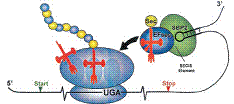Biochemistry, Department of

Vadim Gladyshev Publications
Document Type
Article
Date of this Version
August 2007
Abstract
Selenocysteine (Sec, U) insertion into proteins is directed by translational recoding of specific UGA codons located upstream of a stemloop structure known as Sec insertion sequence (SECIS) element. Selenoproteins with known functions are oxidoreductases containing a single redox-active Sec in their active sites. In this work, we identified a family of selenoproteins, designated SelL, containing two Sec separated by two other residues to form a UxxU motif. SelL proteins show an unusual occurrence, being present in diverse aquatic organisms, including fi sh, invertebrates, and marine bacteria. Both eukaryotic and bacterial SelL genes use single SECIS elements for insertion of two Sec. In eukaryotes, the SECIS is located in the 3’ UTR, whereas the bacterial SelL SECIS is within a coding region and positioned at a distance that supports the insertion of either of the two Sec or both of these residues. SelL proteins possess a thioredoxin- like fold wherein the UxxU motif corresponds to the catalytic CxxC motif in thioredoxins, suggesting a redox function of SelL proteins. Distantly related SelL-like proteins were also identified in a variety of organisms that had either one or both Sec replaced with Cys. Danio rerio SelL, transiently expressed in mammalian cells, incorporated two Sec and localized to the cytosol. In these cells, it occurred in an oxidized form and was not reducible by DTT. In a bacterial expression system, we directly demonstrated the formation of a diselenide bond between the two Sec, establishing it as the fi rst diselenide bond found in a natural protein.


Comments
Published in Proceedings of the National Academy of Sciences of the USA 104:35 (August 28, 2007), pp. 13919–13924; DOI 10.1073/pnas.0703448104 Copyright © 2007 by The National Academy of Sciences of the USA. Used by permission.